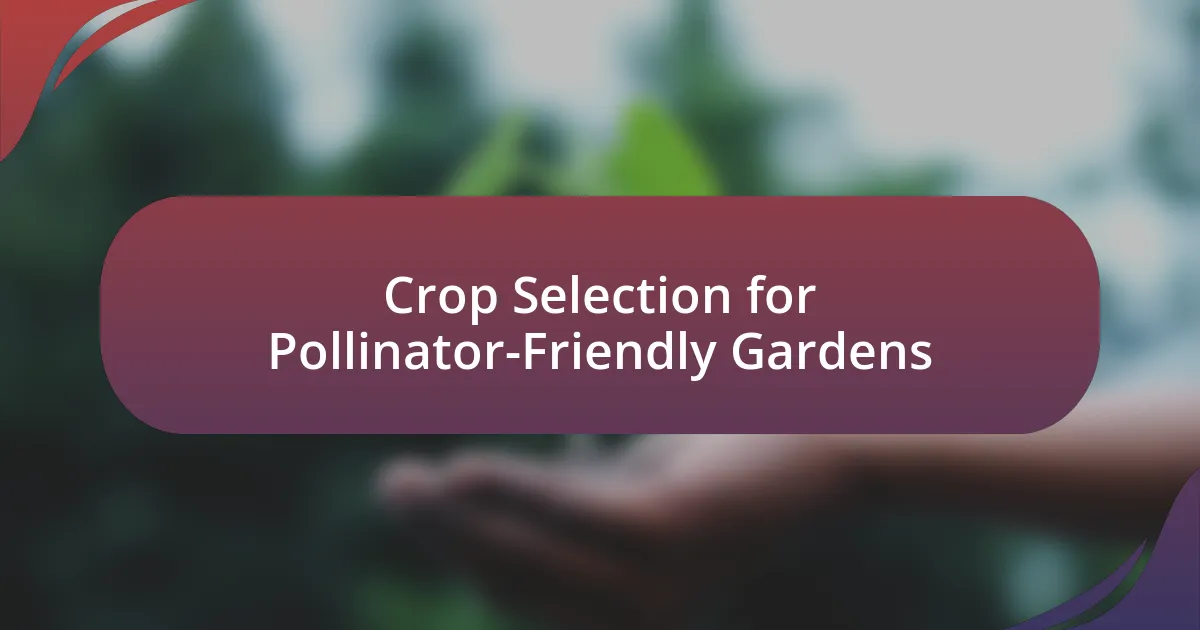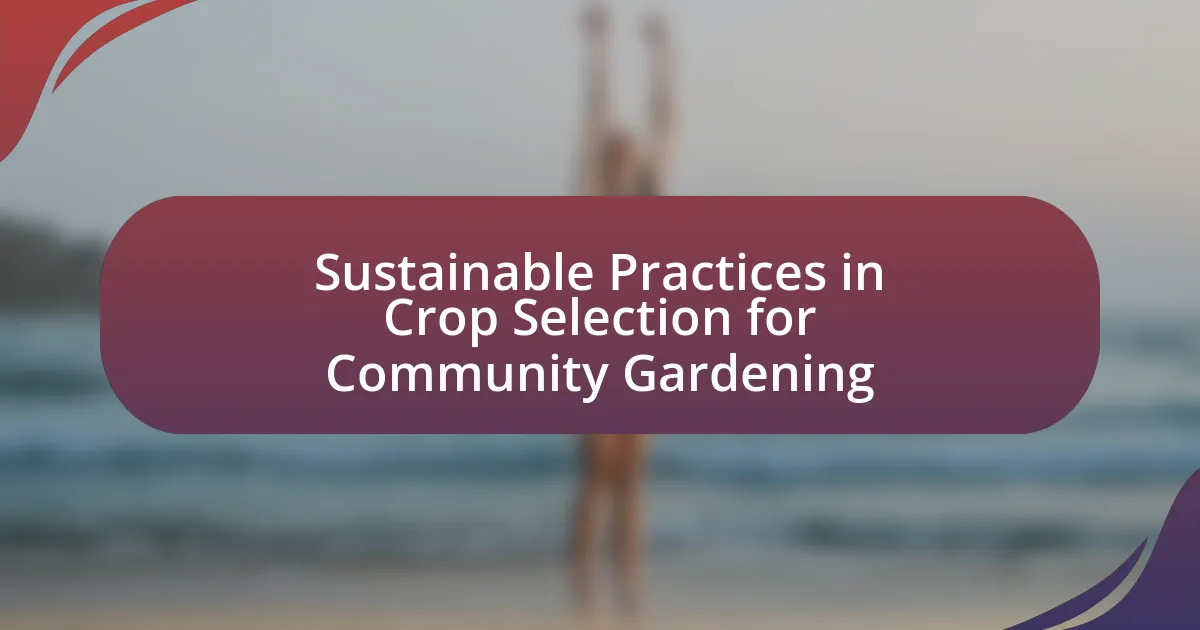The article focuses on the best companion plants for urban community gardens, highlighting their benefits in enhancing growth, pest control, and overall garden health. Key companion plants discussed include basil, marigolds, beans, and nasturtiums, each contributing to improved yields and biodiversity. The article outlines the ecological advantages of companion planting, factors to consider when selecting plants, and strategies for effective implementation. Additionally, it addresses common challenges and solutions related to plant compatibility and pest management, providing practical tips for urban gardeners to optimize their gardening efforts.

What are the Best Companion Plants for Urban Community Gardens?
The best companion plants for urban community gardens include basil, which enhances the growth and flavor of tomatoes, and marigolds, known for repelling pests like nematodes and aphids. Additionally, beans fix nitrogen in the soil, benefiting neighboring plants, while nasturtiums attract beneficial insects and deter harmful ones. Research indicates that these combinations can lead to healthier plants and increased yields, making them ideal for urban gardening environments.
How do companion plants benefit urban community gardens?
Companion plants benefit urban community gardens by enhancing biodiversity, improving pest control, and increasing crop yields. These plants can attract beneficial insects, such as pollinators and natural predators of pests, which helps maintain a balanced ecosystem. For example, marigolds are known to repel nematodes and attract ladybugs, which feed on aphids. Additionally, certain combinations of plants can improve nutrient uptake; for instance, legumes fix nitrogen in the soil, benefiting neighboring plants. Research indicates that companion planting can lead to a 20-50% increase in yields compared to monoculture systems, demonstrating its effectiveness in urban gardening settings.
What are the ecological advantages of using companion plants?
Companion plants provide several ecological advantages, including enhanced biodiversity, improved pest control, and increased soil health. By planting different species together, gardens can attract beneficial insects that help pollinate plants and control pest populations, reducing the need for chemical pesticides. For example, marigolds are known to repel nematodes and attract pollinators, while legumes can fix nitrogen in the soil, improving fertility for neighboring plants. This symbiotic relationship among plants fosters a more resilient ecosystem, promoting sustainability in urban community gardens.
How do companion plants enhance crop yields?
Companion plants enhance crop yields by improving nutrient availability, pest control, and pollination. For instance, legumes like beans fix nitrogen in the soil, benefiting neighboring plants that require nitrogen for growth. Additionally, certain plants, such as marigolds, repel pests that would otherwise damage crops, leading to healthier plants and increased yields. Research has shown that intercropping, a method that utilizes companion planting, can increase yields by up to 20% compared to monoculture systems, demonstrating the effectiveness of this agricultural practice.
What factors should be considered when selecting companion plants?
When selecting companion plants, factors such as plant compatibility, growth habits, pest control, nutrient requirements, and environmental conditions must be considered. Plant compatibility ensures that chosen species can coexist without competing for resources or inhibiting each other’s growth. Growth habits, including height and spread, affect light availability and airflow, which are crucial for plant health. Pest control is enhanced when certain plants repel pests or attract beneficial insects, thereby reducing the need for chemical interventions. Nutrient requirements should align to prevent depletion of soil nutrients, ensuring that all plants thrive. Lastly, environmental conditions like sunlight, soil type, and moisture levels must match the needs of the companion plants to promote optimal growth and yield.
How does plant compatibility affect growth and health?
Plant compatibility significantly influences growth and health by enhancing nutrient uptake, reducing pest infestations, and improving overall plant vigor. When compatible plants are grown together, they can share resources such as water and nutrients more effectively, leading to healthier plants. For instance, legumes fix nitrogen in the soil, benefiting neighboring plants that require nitrogen, thus promoting better growth. Additionally, certain plant combinations can deter pests; for example, marigolds are known to repel nematodes and other harmful insects, which helps protect companion plants. Studies have shown that companion planting can increase yields by up to 20% compared to monoculture systems, demonstrating the tangible benefits of plant compatibility on growth and health.
What role does climate play in choosing companion plants?
Climate significantly influences the selection of companion plants by determining their growth conditions and compatibility. Different plants thrive in specific temperature ranges, humidity levels, and sunlight exposure, which are all dictated by the local climate. For instance, warm-season crops like tomatoes and peppers require a climate with higher temperatures, while cool-season crops such as lettuce and peas flourish in cooler conditions. Additionally, climate affects pest and disease prevalence, which can guide gardeners in choosing companion plants that naturally repel pests or enhance resilience against diseases. Research indicates that understanding local climate patterns can lead to more successful plant pairings, ultimately improving yield and plant health in urban community gardens.

Which specific plants are ideal companions in urban gardens?
Marigolds, basil, and nasturtiums are ideal companion plants in urban gardens. Marigolds deter pests such as nematodes and aphids, enhancing the health of neighboring plants. Basil improves the growth and flavor of tomatoes when planted nearby, while nasturtiums attract beneficial insects and repel harmful ones, creating a balanced ecosystem. These plants not only support each other but also thrive in limited space, making them suitable for urban gardening.
What are the top companion plants for vegetables?
The top companion plants for vegetables include marigolds, basil, and nasturtiums. Marigolds are known to repel nematodes and other pests, enhancing the health of nearby vegetables. Basil, when planted alongside tomatoes, can improve their flavor and deter pests like aphids and whiteflies. Nasturtiums serve as a trap crop, attracting aphids away from more valuable vegetables. These companion plants not only promote pest control but also enhance growth and yield, making them essential for urban community gardens.
How do marigolds support tomato plants?
Marigolds support tomato plants by repelling harmful pests such as nematodes and aphids. The presence of marigolds in the garden can deter these pests due to their strong scent and the compounds they release, which are unappealing to many insects. Research has shown that marigolds can reduce nematode populations in the soil, thereby promoting healthier tomato plant growth and improving yield. This symbiotic relationship enhances the overall health of the garden ecosystem, making marigolds an effective companion plant for tomatoes.
What benefits do basil and peppers provide when planted together?
Basil and peppers provide several benefits when planted together, primarily through pest control and enhanced growth. Basil acts as a natural repellent for pests such as aphids and spider mites, which can harm pepper plants. Additionally, the aromatic compounds released by basil can improve the flavor and growth rate of peppers. Research indicates that companion planting can increase yields by up to 20%, demonstrating the effectiveness of this pairing in urban community gardens.
What flowers can enhance the health of community gardens?
Marigolds can enhance the health of community gardens by repelling pests and attracting beneficial insects. Specifically, Tagetes species, commonly known as marigolds, produce compounds that deter nematodes and aphids, which are harmful to many garden plants. Additionally, their bright flowers attract pollinators such as bees and butterflies, promoting biodiversity and improving pollination rates in the garden. Research has shown that marigolds can reduce pest populations significantly, thereby contributing to a healthier garden ecosystem.
How do nasturtiums attract beneficial insects?
Nasturtiums attract beneficial insects primarily through their bright flowers and the production of nectar. The vibrant colors of nasturtium flowers draw pollinators such as bees and butterflies, while the nectar serves as a food source for these insects. Additionally, nasturtiums can act as a trap crop, luring aphids away from other plants, which in turn encourages predatory insects like ladybugs and lacewings to inhabit the garden. This dual role enhances biodiversity and promotes a healthier ecosystem within urban community gardens.
What role do sunflowers play in urban gardens?
Sunflowers serve multiple roles in urban gardens, primarily as attractors of pollinators and as natural pest deterrents. Their large, vibrant blooms draw bees, butterflies, and other beneficial insects, which are essential for pollination and enhancing biodiversity in urban environments. Additionally, sunflowers can repel certain pests due to their natural oils, reducing the need for chemical pesticides. Research indicates that companion planting with sunflowers can improve the overall health and yield of neighboring plants by fostering a balanced ecosystem.

How can urban gardeners implement companion planting effectively?
Urban gardeners can implement companion planting effectively by selecting plant combinations that enhance growth, deter pests, and improve soil health. For instance, planting marigolds alongside tomatoes can repel nematodes and other pests, while beans can fix nitrogen in the soil, benefiting neighboring plants. Research indicates that companion planting can increase yields by up to 20% due to improved plant interactions and reduced pest pressure. By strategically planning their garden layout and understanding the specific benefits of various plant pairings, urban gardeners can maximize their garden’s productivity and sustainability.
What strategies can be used for successful companion planting?
Successful companion planting strategies include selecting plants that enhance each other’s growth, deter pests, and improve soil health. For instance, planting marigolds alongside vegetables can repel nematodes and other pests, while legumes like beans can fix nitrogen in the soil, benefiting neighboring plants. Additionally, using a diverse planting scheme can create a balanced ecosystem, reducing the likelihood of disease and pest outbreaks. Research indicates that companion planting can increase yields by up to 20% compared to monoculture systems, demonstrating its effectiveness in urban community gardens.
How can gardeners design their plots for optimal plant pairing?
Gardeners can design their plots for optimal plant pairing by utilizing companion planting strategies that enhance growth, deter pests, and improve soil health. For instance, planting tomatoes alongside basil can increase tomato yields and flavor, as basil repels pests like aphids and whiteflies. Additionally, incorporating legumes such as beans can fix nitrogen in the soil, benefiting neighboring plants like corn and squash. Research indicates that companion planting can lead to a 20-50% increase in crop yields, demonstrating its effectiveness in urban community gardens.
What are the best practices for maintaining companion plants?
The best practices for maintaining companion plants include ensuring proper spacing, regular watering, and monitoring for pests and diseases. Proper spacing allows each plant to access sunlight and nutrients without competition, which is crucial for their growth. Regular watering is essential, as companion plants often have varying water needs; thus, understanding the specific requirements of each plant helps maintain their health. Additionally, monitoring for pests and diseases enables early intervention, which can prevent damage to both the companion plants and the overall garden ecosystem. Research indicates that companion planting can enhance biodiversity and improve crop yields, making these practices vital for successful urban community gardens.
What common challenges arise with companion planting?
Common challenges that arise with companion planting include misidentification of compatible plants, competition for resources, and pest attraction. Misidentification can lead to planting species that do not benefit each other, undermining the intended advantages of companion planting. Competition for nutrients, water, and sunlight can occur when plants with similar needs are grown together, potentially stunting growth. Additionally, some companion plants may inadvertently attract pests that can harm neighboring crops, negating the benefits of the companion planting strategy. These challenges highlight the importance of thorough research and planning in urban community gardens to ensure successful companion planting.
How can gardeners troubleshoot issues with incompatible plants?
Gardeners can troubleshoot issues with incompatible plants by assessing their growth requirements, such as light, water, and soil conditions, and adjusting these factors accordingly. For example, if one plant thrives in full sun while another prefers shade, gardeners can relocate the plants or provide shade structures to create a suitable environment for both. Additionally, gardeners should monitor for pest and disease interactions, as some plants may attract harmful insects that affect their neighbors. Research indicates that certain combinations, like tomatoes and basil, can enhance growth, while others, like beans and onions, can hinder it due to allelopathy, where one plant releases chemicals that negatively impact another. By understanding these relationships and making necessary adjustments, gardeners can effectively manage plant compatibility in their gardens.
What solutions exist for pests that threaten companion plants?
Solutions for pests that threaten companion plants include the use of natural predators, organic pesticides, and companion planting strategies. Natural predators, such as ladybugs and lacewings, effectively control aphid populations, which can harm companion plants. Organic pesticides, like neem oil and insecticidal soap, provide a safe alternative to chemical treatments, targeting specific pests without harming beneficial insects. Additionally, companion planting strategies, such as intercropping marigolds with vegetables, can deter pests through natural repellents and attract beneficial insects, enhancing overall garden health. These methods are supported by research indicating that integrated pest management practices improve plant resilience and reduce pest damage in urban gardens.
What are some practical tips for urban community gardeners?
Urban community gardeners should focus on selecting plants that thrive together, maximizing space, and utilizing sustainable practices. For instance, planting basil alongside tomatoes can enhance growth and flavor, as basil repels pests that typically affect tomatoes. Additionally, gardeners should consider vertical gardening techniques to optimize limited space, such as using trellises for climbing plants like cucumbers and beans. Implementing composting practices enriches soil health and reduces waste, with studies showing that compost can improve plant growth by providing essential nutrients. Regularly rotating crops also helps prevent soil depletion and reduces pest buildup, ensuring a healthier garden ecosystem.





